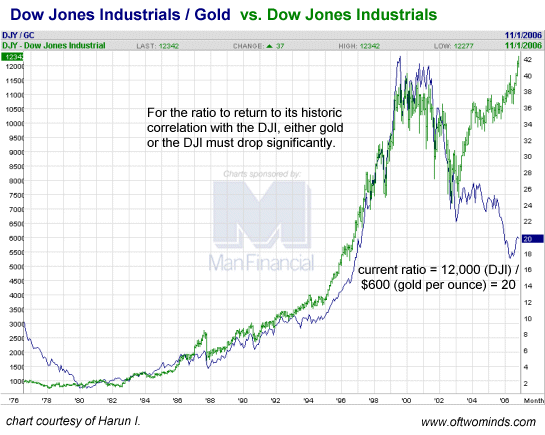

|
| weblog/wEssays archives | home | |
|
Beneath the Surface, Part III: The Dow and Gold (November 29, 2006) Frequent contributor Harun I. was kind enough to provide this chart of the Dow Jones Industrial Average (DJI) and the DJI in a ratio with gold (DJI/gold). AT first glance you notice a rather startling disconnect which occurred at the market low in 2002. 
From approximately 1980 through 2002, the ratio of the Dow and gold moved in sync (i.e. was in correlation) with the Dow Jones Industrials. But since the market low in 2002, the two have radically diverged. Now it is always possible that a historic correlation has been broken. But it behooves those of us trying not to lose whatever capital we might have in this world to consider an alternative: that the divergence will return to convergence. One way for this to happen would be for gold to drop in half to $300/ounce. Then the ratio of the DJI to gold would be 40 (12,000 / $300 = 40). Another way would be for the DJI to drop back to the neighborhood of 1,000, where it was in 1980. At that point, the Dow and the price of gold were roughly equal (800 and $800). In the current euphoria of a world awash with liquidity, leveraged assets (derivatives) and a mad scramble for higher yields, such possibilities sound absurd. But just for the sake of argument, what would it take for gold to plummet from $600 to $300? A mighty rise in the dollar, perhaps; and what might trigger such a massive appreciation in the dollar? A complete collapse of the yen and euro, perhaps? But with the U.S. current account deficit already at an unsustainable 7% of GDP, what would cause our trading partners' currencies to collapse and the dollar to double? I am open to the possibility, but the fundamentals behind such a move are unclear. The likelier possibility is a collapse in the dollar and a doubling of the price of gold. Could the Dow fall to 1,000? Various Elliott Wave theorists suggest this is a possibility. What could induce such as drastic collapse of valuation? One mechanism would be high inflation; when Treasuries are paying 15%, stocks are unattractive in the extreme. Another is a collapse in profitability; if a global recession decimated the profits of the DJI companies (for instance, orders for new Boeing jets were cancelled because air traffic had fallen off a cliff, and the need for more Cisco routers vanishes), then on a purely mechanical price-to-earnings basis the Dow could shrink to 1,000. At Bear market lows, the PE ratio sinks to around 8, which is roughly a third of the current Dow PE ratio. In other words, based on a Bear market PE, the Dow could fall to 4,000 with no reduction of actual profit. It's certainly something to ponder. (A.M. addendum: Harun just reminded me of yet another alternative--that the DJI will continue its stratospheric climb. Given the liquidity and euphoria of the past five months, this is entirely possible.) For more on this subject and a wide array of other topics, please visit my weblog. copyright © 2006 Charles Hugh Smith. All rights reserved in all media. I would be honored if you linked this wEssay to your site, or printed a copy for your own use. |
||
| weblog/wEssays | home |